TOYOTA AVALON 2022 Owners Manual
Manufacturer: TOYOTA, Model Year: 2022, Model line: AVALON, Model: TOYOTA AVALON 2022Pages: 572, PDF Size: 9.42 MB
Page 491 of 572
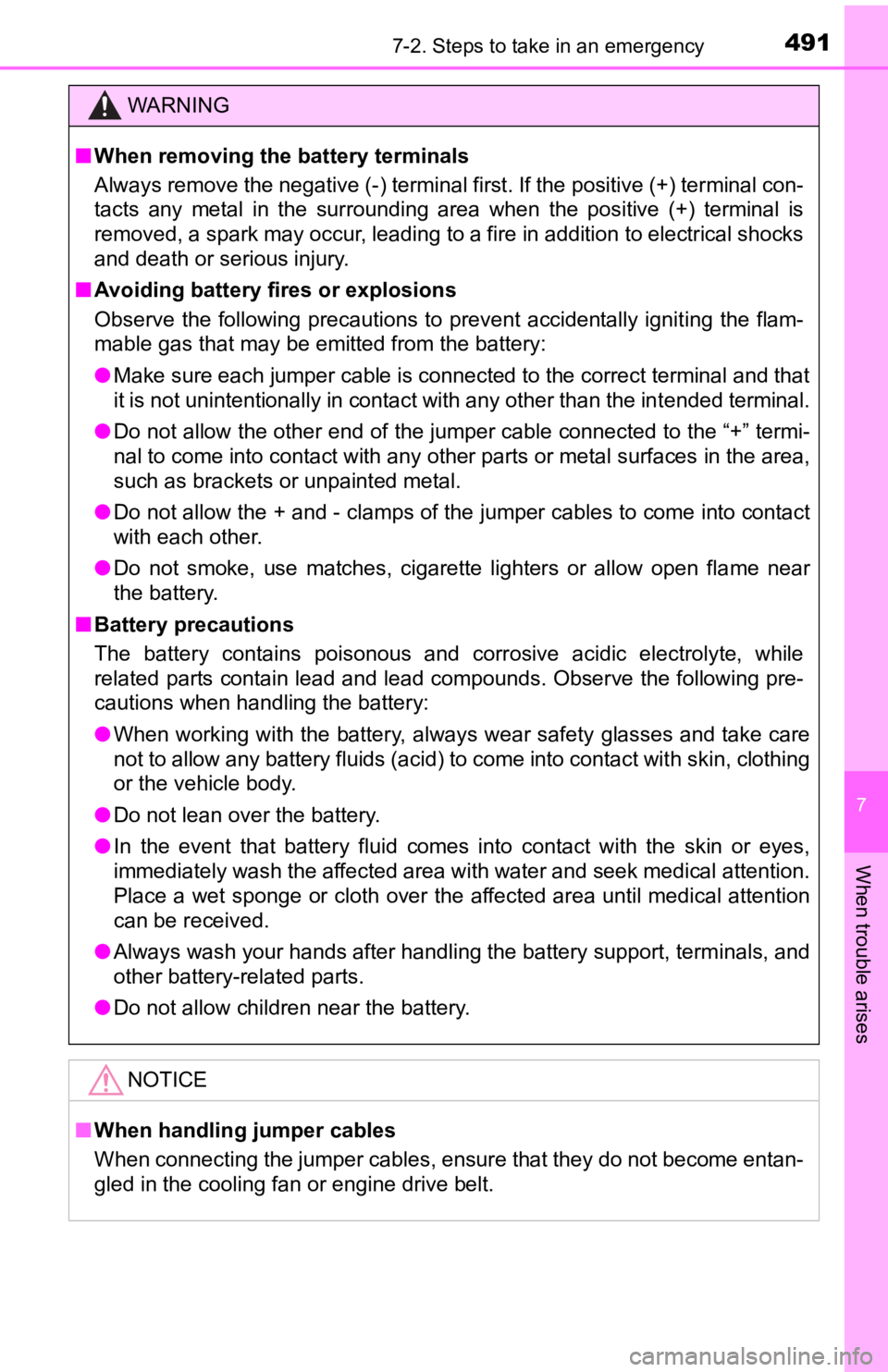
4917-2. Steps to take in an emergency
7
When trouble arises
WARNING
■When removing the battery terminals
Always remove the negative (-) terminal first. If the positive (+) terminal con-
tacts any metal in the surrounding area when the positive (+) terminal is
removed, a spark may occur, leading to a fire in addition to el ectrical shocks
and death or serious injury.
■ Avoiding battery fires or explosions
Observe the following precautions to prevent accidentally ignit ing the flam-
mable gas that may be emitted from the battery:
● Make sure each jumper cable is connected to the correct terminal and that
it is not unintentionally in contact with any other than the in tended terminal.
● Do not allow the other end of the jumper cable connected to the “+” termi-
nal to come into contact with any other parts or metal surfaces in the area,
such as brackets or unpainted metal.
● Do not allow the + and - clamps of the jumper cables to come into contact
with each other.
● Do not smoke, use matches, cigarette lighters or allow open fla me near
the battery.
■ Battery precautions
The battery contains poisonous and corrosive acidic electrolyte, while
related parts contain lead and lead compounds. Observe the following pre-
cautions when handling the battery:
● When working with the battery, always wear safety glasses and take care
not to allow any battery fluids (acid) to come into contact with skin, clothing
or the vehicle body.
● Do not lean over the battery.
● In the event that battery fluid comes into contact with the skin or eyes,
immediately wash the affected area with water and seek medical attention.
Place a wet sponge or cloth over the affected area until medical attention
can be received.
● Always wash your hands after handling the battery support, terminals, and
other battery-related parts.
● Do not allow children near the battery.
NOTICE
■When handling jumper cables
When connecting the jumper cables, ensure that they do not beco me entan-
gled in the cooling fan or engine drive belt.
Page 492 of 572
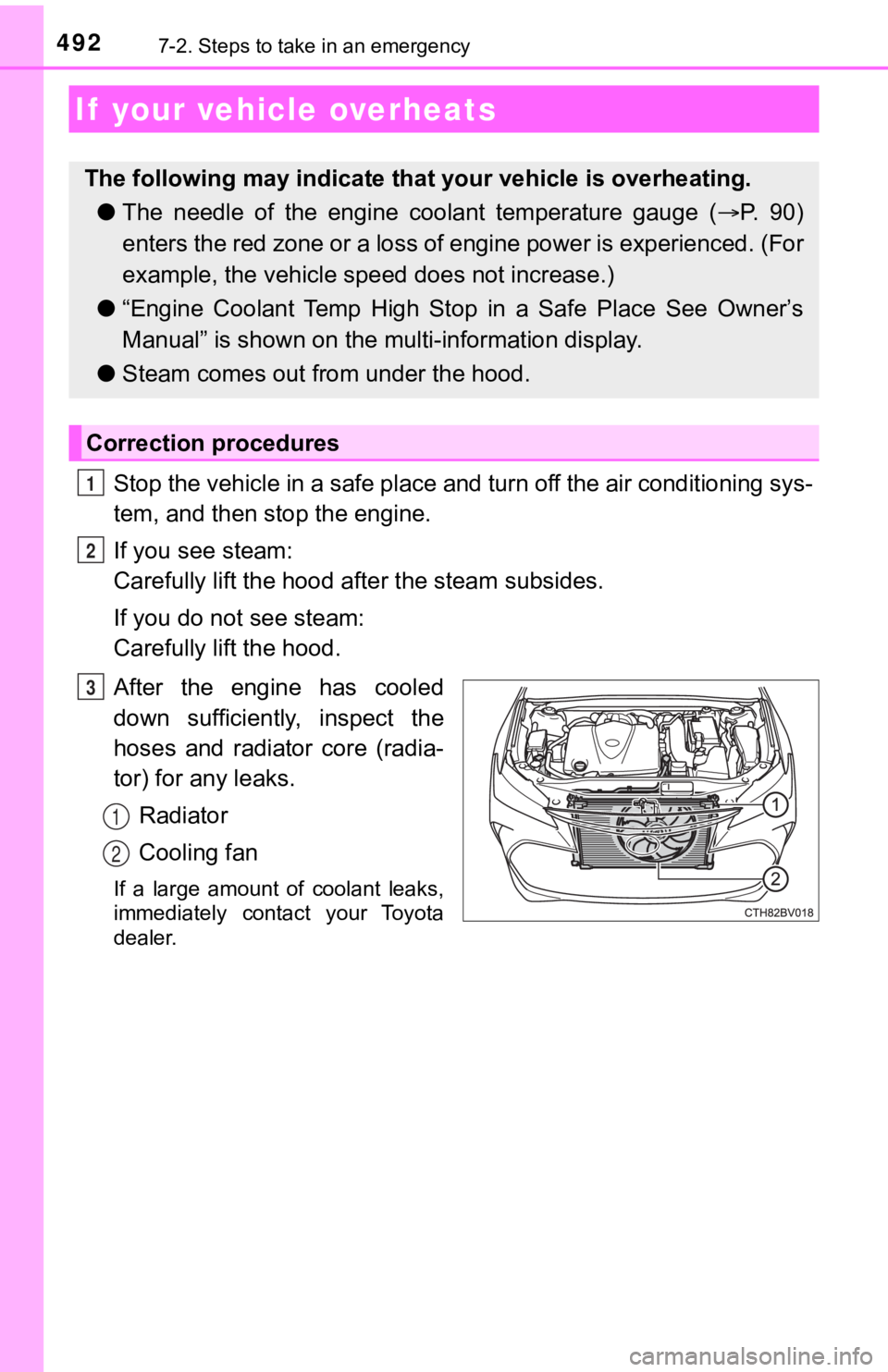
4927-2. Steps to take in an emergency
Stop the vehicle in a safe place and turn off the air conditioning sys-
tem, and then stop the engine.
If you see steam:
Carefully lift the hood after the steam subsides.
If you do not see steam:
Carefully lift the hood.
After the engine has cooled
down sufficiently, inspect the
hoses and radiator core (radia-
tor) for any leaks. Radiator
Cooling fan
If a large amount of coolant leaks,
immediately contact your Toyota
dealer.
If your vehicle overheats
The following may indicate that your vehicle is overheating.
● The needle of the engine c oolant temperature gauge (P. 90)
enters the red zone or a loss of engine power is experienced. ( For
example, the vehicle s peed does not increase.)
● “Engine Coolant Temp High Stop in a Safe Place See Owner’s
Manual” is shown on the mult i-information display.
● Steam comes out from under the hood.
Correction procedures
1
2
3
1
2
Page 493 of 572
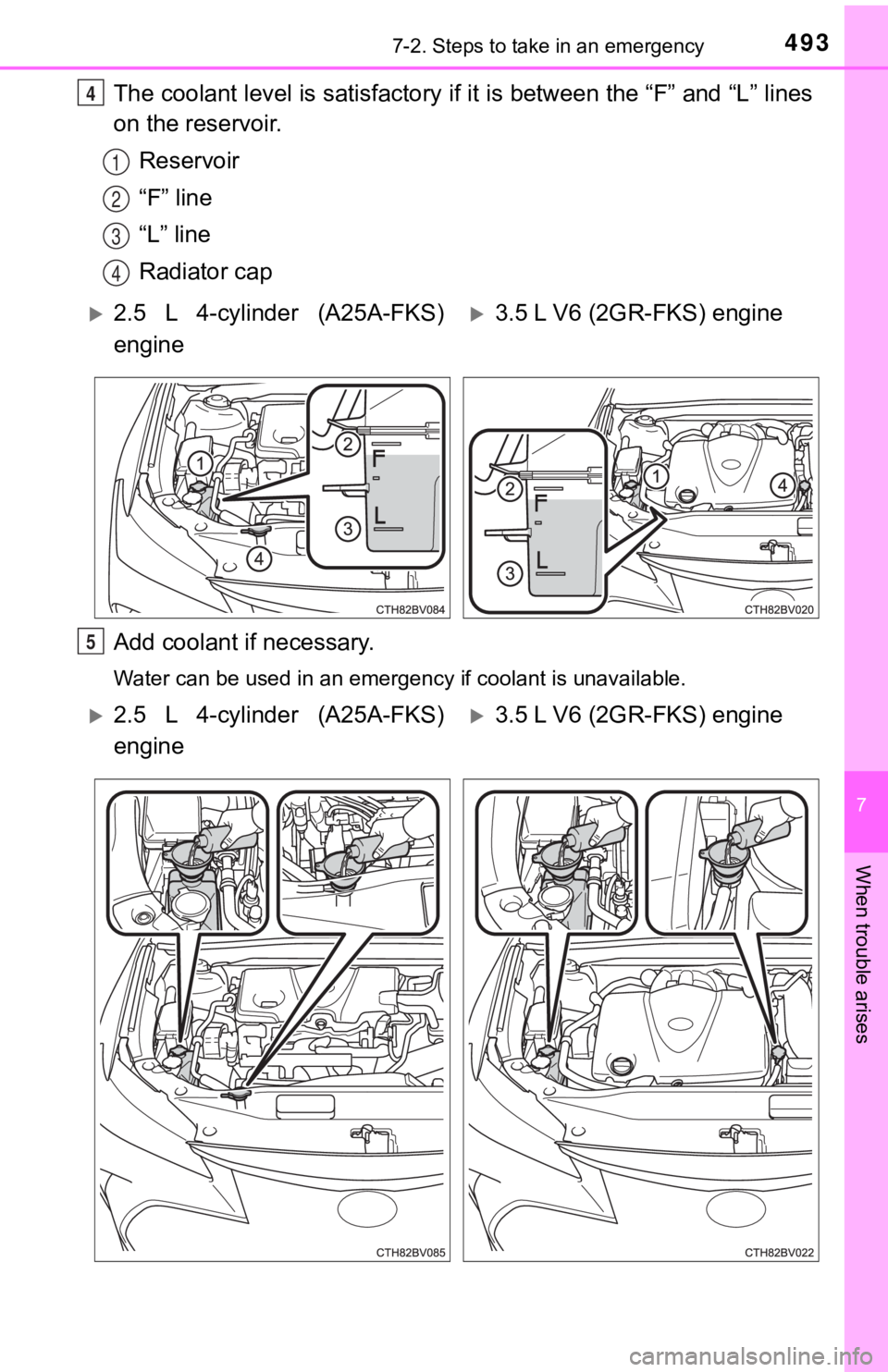
4937-2. Steps to take in an emergency
7
When trouble arises
The coolant level is satisfactory if it is between the “F” and “L” lines
on the reservoir.
Reservoir
“F” line
“L” line
Radiator cap
Add coolant if necessary.
Water can be used in an emergency if coolant is unavailable.
4
1
2
3
4
2.5 L 4-cylinder (A25A-FKS)
engine3.5 L V6 (2GR-FKS) engine
5
2.5 L 4-cylinder (A25A-FKS)
engine3.5 L V6 (2GR-FKS) engine
Page 494 of 572
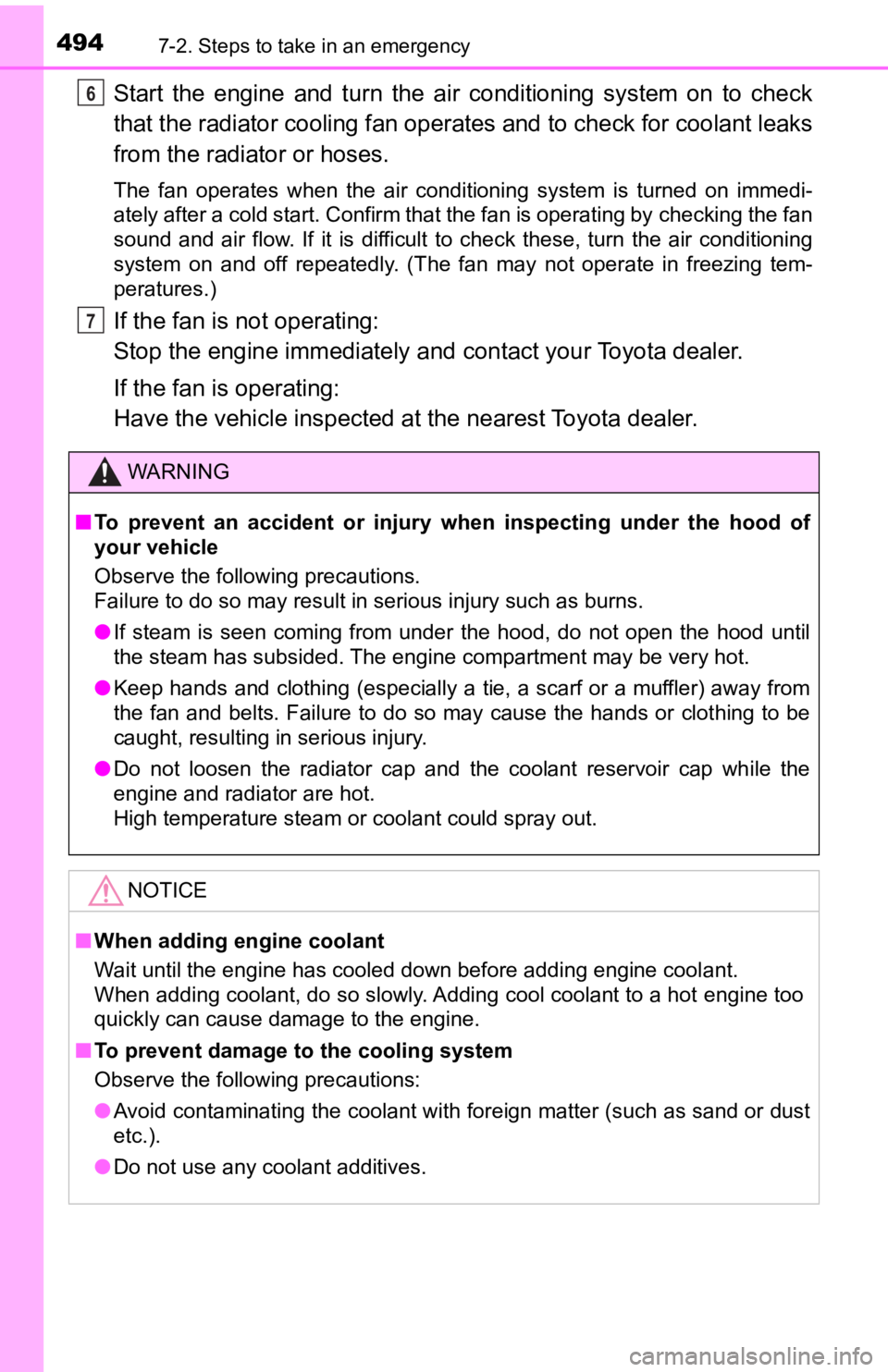
4947-2. Steps to take in an emergency
Start the engine and turn the air conditioning system on to check
that the radiator cooling fan operates and to check for coolant leaks
from the radiator or hoses.
The fan operates when the air conditioning system is turned on immedi-
ately after a cold start. Confirm that the fan is operating by checking the fan
sound and air flow. If it is difficult to check these, turn the air conditioning
system on and off repeatedly. (The fan may not operate in freezing tem-
peratures.)
If the fan is not operating:
Stop the engine immediately and contact your Toyota dealer.
If the fan is operating:
Have the vehicle inspected at the neare st Toyota dealer.
WARNING
■To prevent an accident or injury when inspecting under the hood of
your vehicle
Observe the following precautions.
Failure to do so may result in serious injury such as burns.
● If steam is seen coming from under the hood, do not open the ho od until
the steam has subsided. The engine compartment may be very hot.
● Keep hands and clothing (especially a tie, a scarf or a muffler) away from
the fan and belts. Failure to do so may cause the hands or clothing to be
caught, resulting in serious injury.
● Do not loosen the radiator cap and the coolant reservoir cap while the
engine and radiator are hot.
High temperature steam or coolant could spray out.
NOTICE
■When adding engine coolant
Wait until the engine has cooled down before adding engine cool ant.
When adding coolant, do so slowly. Adding cool coolant to a hot engine too
quickly can cause damage to the engine.
■ To prevent damage to the cooling system
Observe the following precautions:
● Avoid contaminating the coolant with foreign matter (such as sa nd or dust
etc.).
● Do not use any coolant additives.
6
7
Page 495 of 572
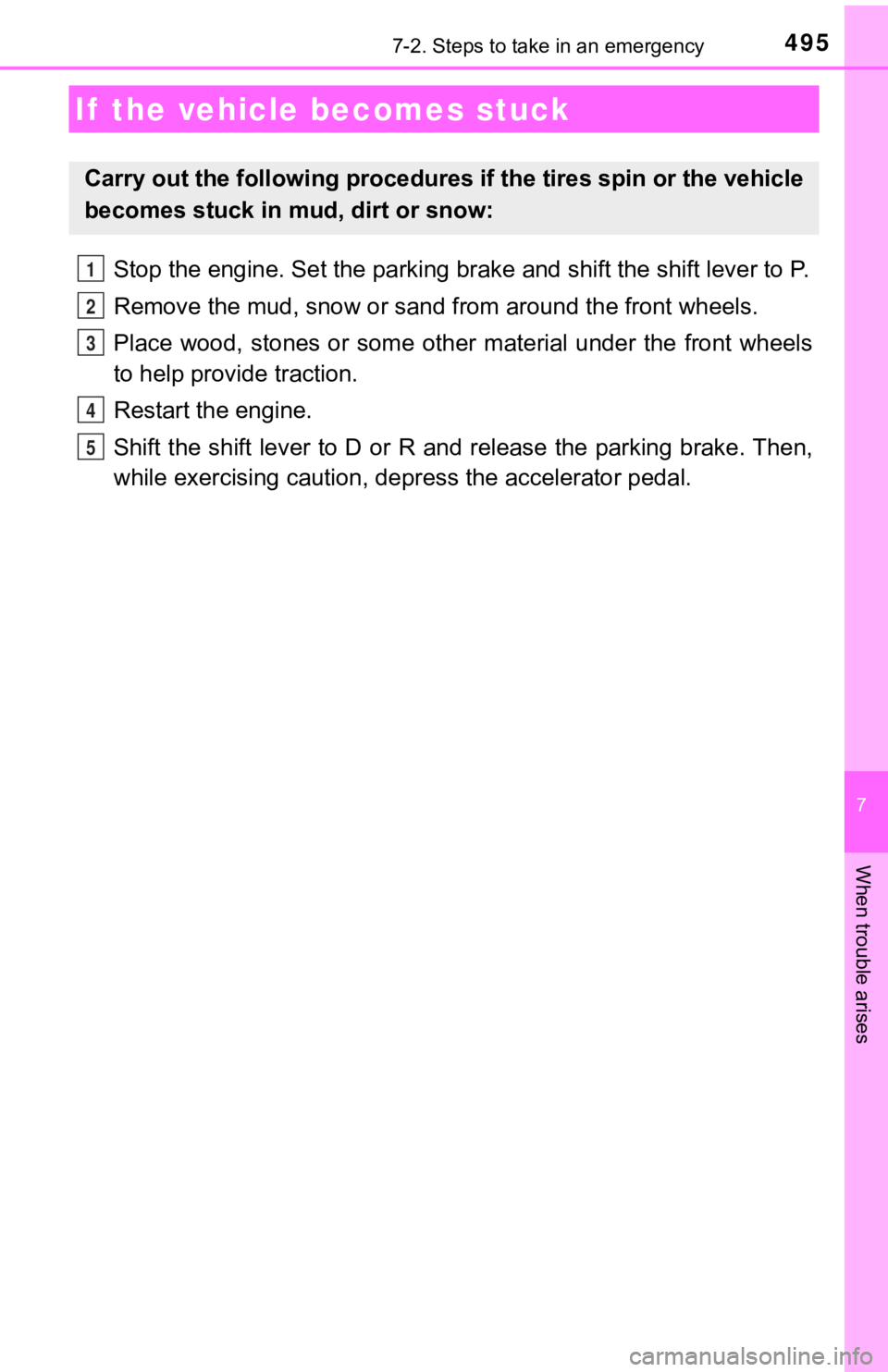
4957-2. Steps to take in an emergency
7
When trouble arises
Stop the engine. Set the parking brake and shift the shift lever to P.
Remove the mud, snow or sand from around the front wheels.
Place wood, stones or some other material under the front wheel s
to help provide traction.
Restart the engine.
Shift the shift lever to D or R and release the parking brake. Then,
while exercising caution, de press the accelerator pedal.
If the vehicle becomes stuck
Carry out the following procedures if the tires spin or the vehicle
becomes stuck in mud, dirt or snow:
1
2
3
4
5
Page 496 of 572
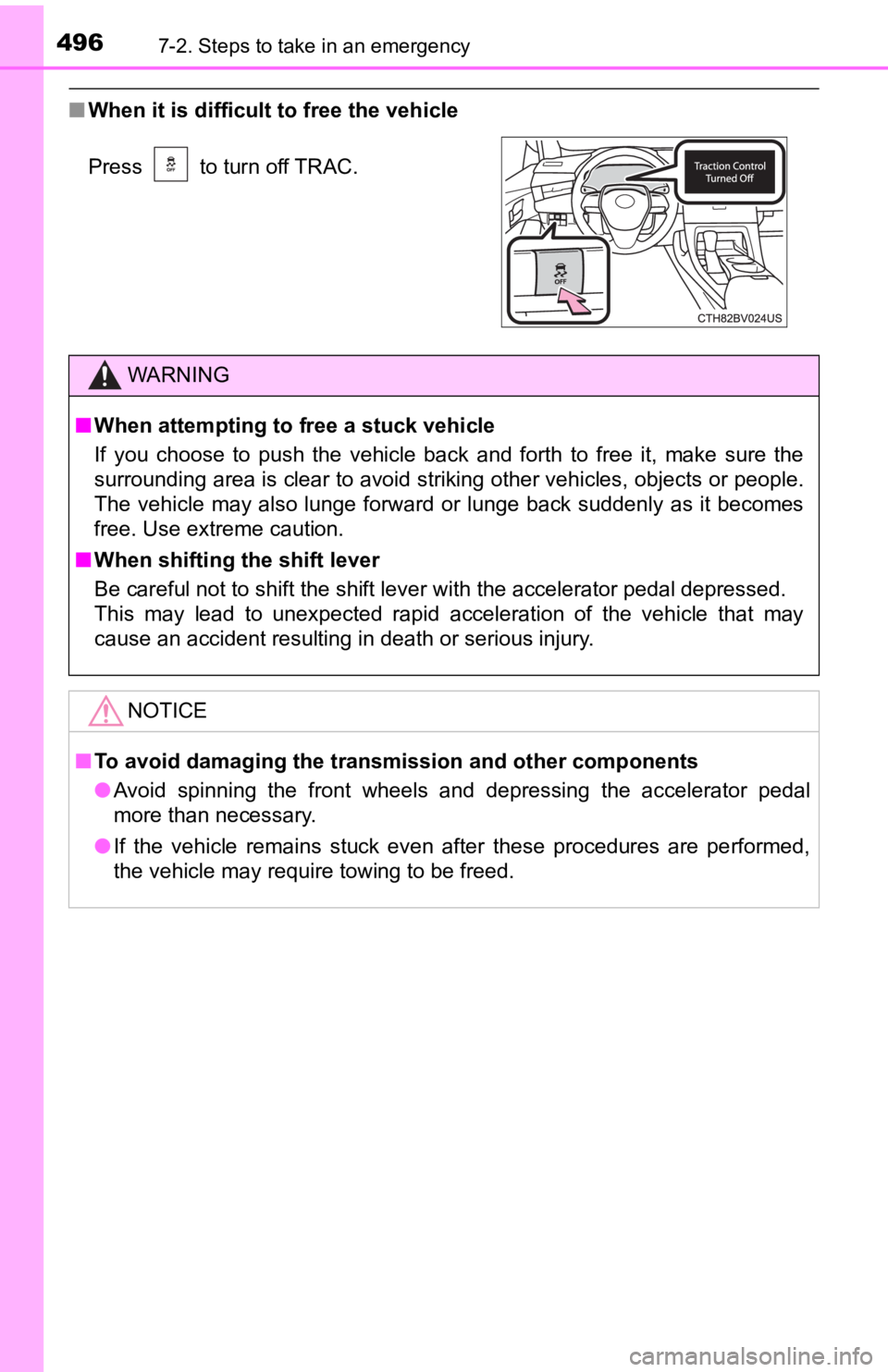
4967-2. Steps to take in an emergency
■When it is difficult to free the vehicle
Press to turn off TRAC.
WARNING
■When attempting to f ree a stuck vehicle
If you choose to push the vehicle back and forth to free it, make sure the
surrounding area is clear to avoid striking other vehicles, obj ects or people.
The vehicle may also lunge forward or lunge back suddenly as it becomes
free. Use extreme caution.
■ When shifting the shift lever
Be careful not to shift the shift lever with the accelerator pedal depressed.
This may lead to unexpected rapid acceleration of the vehicle t hat may
cause an accident resulting in death or serious injury.
NOTICE
■ To avoid damaging the transmission and other components
● Avoid spinning the front wheels and depressing the accelerator pedal
more than necessary.
● If the vehicle remains stuck even after these procedures are pe rformed,
the vehicle may require towing to be freed.
Page 497 of 572

497
8Vehicle specifications
8-1. SpecificationsMaintenance data (fuel, oil level, etc.) .......... 498
Fuel information ................ 509
Tire information ................. 512
8-2. Customization Customizable features ...... 525
8-3. Items to initialize Items to initialize ............... 533
Page 498 of 572
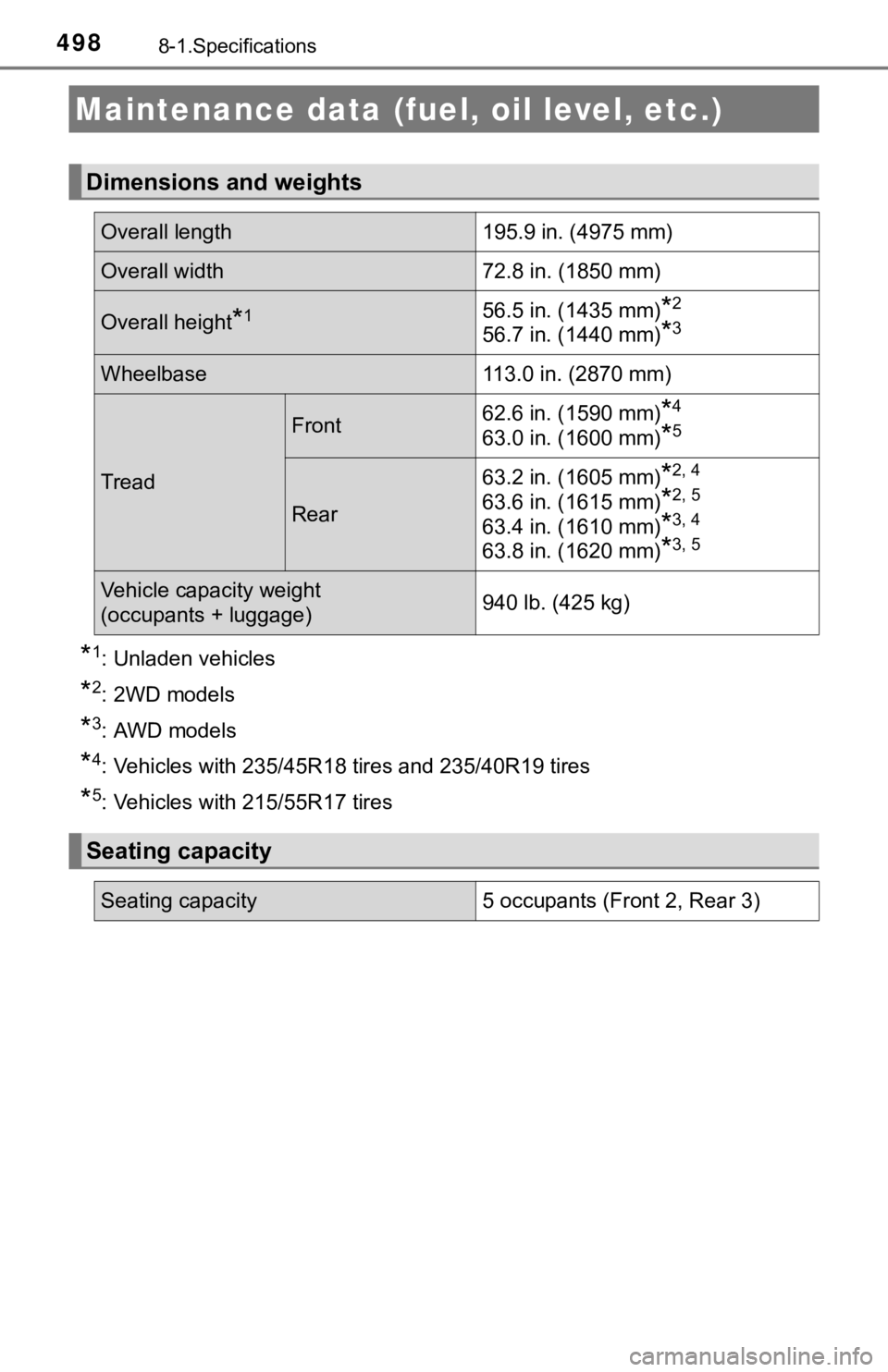
4988-1.Specifications
*1: Unladen vehicles
*2: 2WD models
*3: AWD models
*4: Vehicles with 235/45R18 tires and 235/40R19 tires
*5: Vehicles with 215/55R17 tires
Maintenance data (fuel, oil level, etc.)
Dimensions and weights
Overall length195.9 in. (4975 mm)
Overall width 72.8 in. (1850 mm)
Overall height*156.5 in. (1435 mm)*2
56.7 in. (1440 mm)*3
Wheelbase113.0 in. (2870 mm)
Tread
Front62.6 in. (1590 mm)*4
63.0 in. (1600 mm)*5
Rear63.2 in. (1605 mm)
*2, 4
63.6 in. (1615 mm)*2, 5
63.4 in. (1610 mm)*3, 4
63.8 in. (1620 mm)*3, 5
Vehicle capacity weight
(occupants + luggage)
940 lb. (425 kg)
Seating capacity
Seating capacity
5 occupants (Front 2, Rear 3)
Page 499 of 572
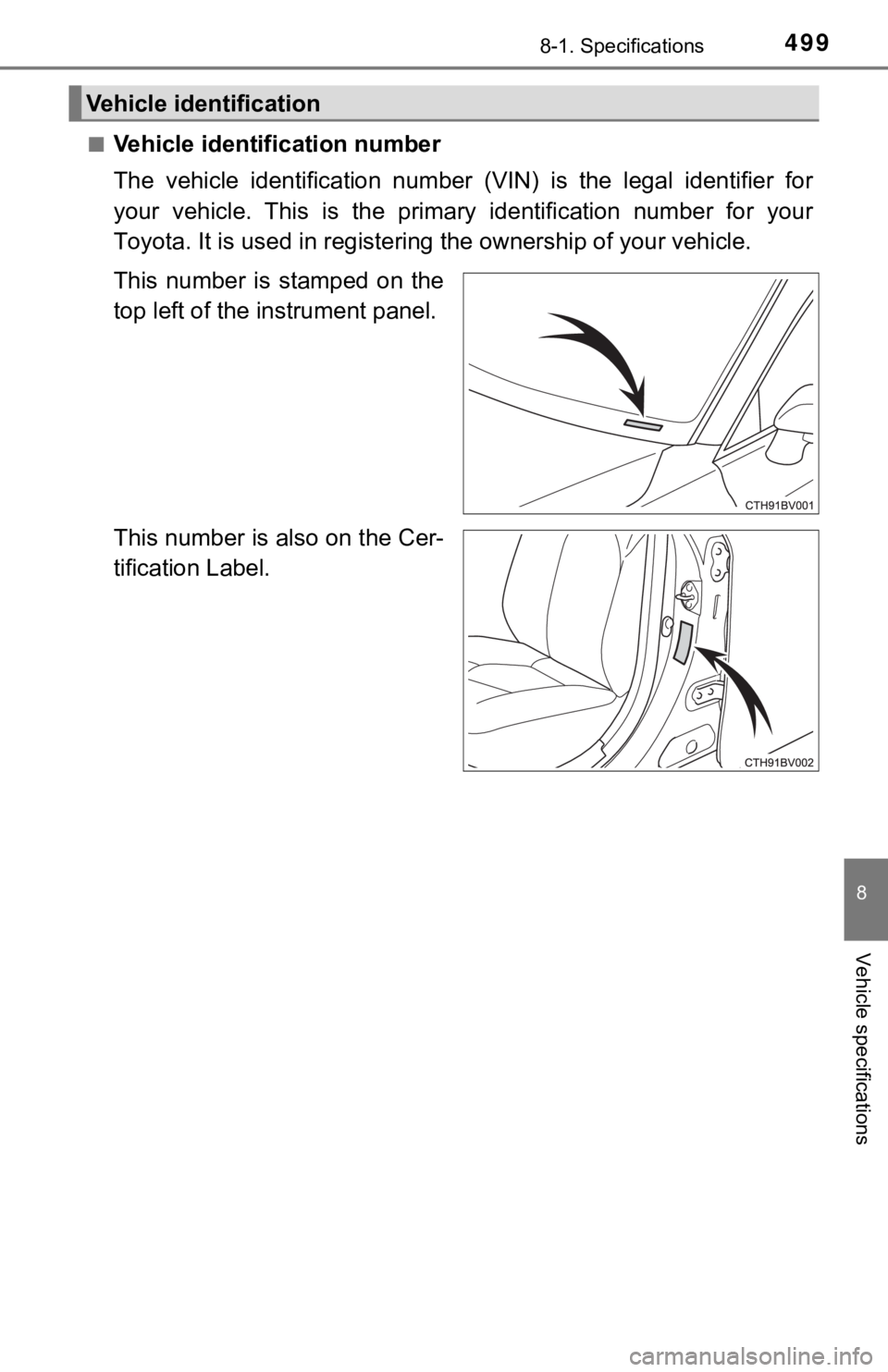
4998-1. Specifications
8
Vehicle specifications
■Vehicle identification number
The vehicle identification number (VIN) is the legal identifier for
your vehicle. This is the primary identification number for you r
Toyota. It is used in registering the ownership of your vehicle.
This number is stamped on the
top left of the instrument panel.
This number is also on the Cer-
tification Label.
Vehicle identification
Page 500 of 572
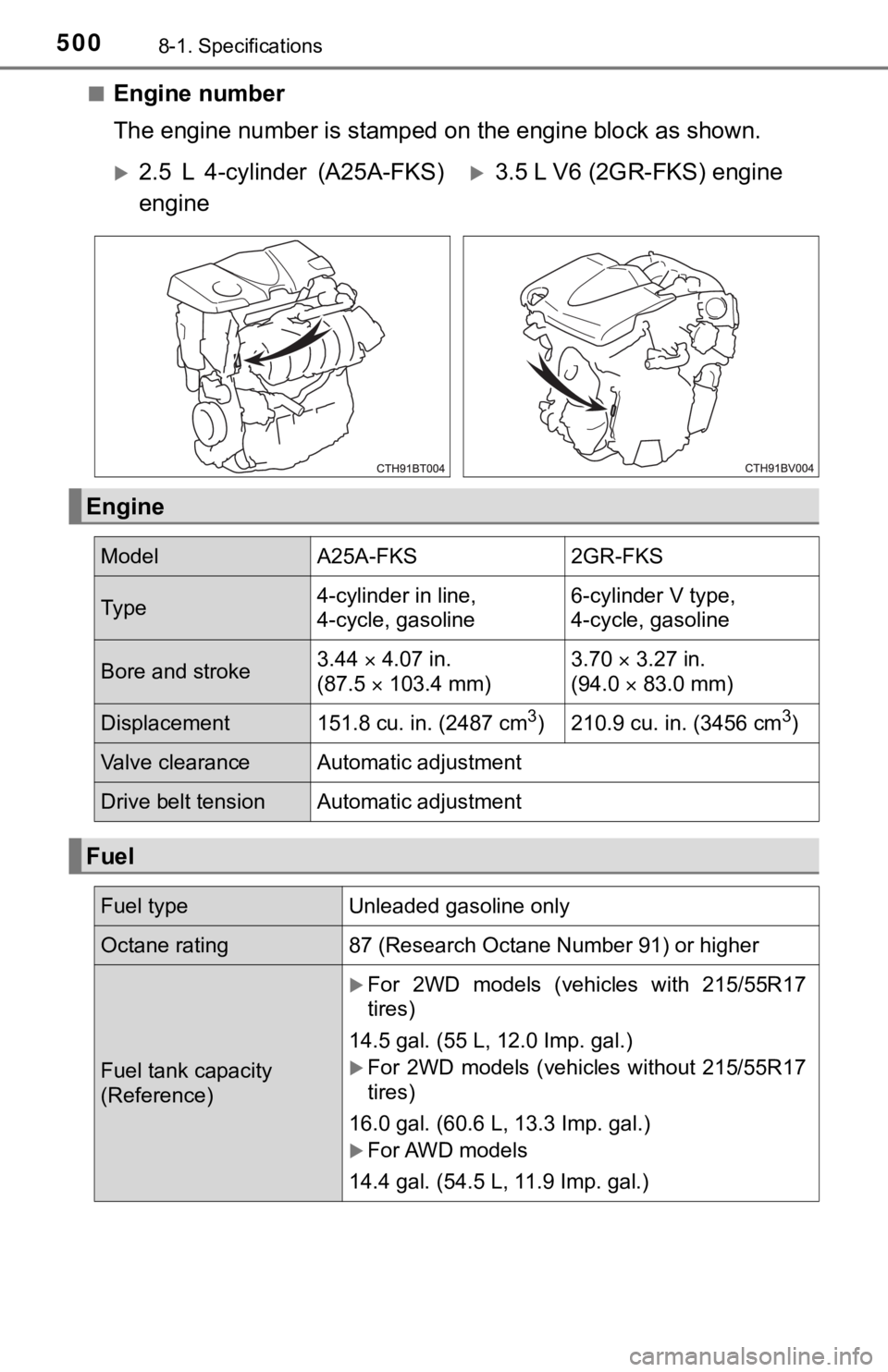
5008-1. Specifications
■Engine number
The engine number is stamped on the engine block as shown.
2.5 L 4-cylinder (A25A-FKS)
engine3.5 L V6 (2GR-FKS) engine
Engine
Model A25A-FKS 2GR-FKS
Ty p e4-cylinder in line,
4-cycle, gasoline 6-cylinder V type,
4-cycle, gasoline
Bore and stroke
3.44
4.07 in.
(87.5 103.4 mm) 3.70
3.27 in.
(94.0 83.0 mm)
Displacement 151.8 cu. in. (2487 cm3) 210.9 cu. in. (3456 cm3)
Valve clearance Automatic adjustment
Drive belt tension Automatic adjustment
Fuel
Fuel type Unleaded gasoline only
Octane rating87 (Research Octane Number 91) or higher
Fuel tank capacity
(Reference)
For 2WD models (vehicles with 215/55R17
tires)
14.5 gal. (55 L, 12.0 Imp. gal.)
For 2WD models (vehicles without 215/55R17
tires)
16.0 gal. (60.6 L, 13.3 Imp. gal.)
For AWD models
14.4 gal. (54.5 L, 11.9 Imp. gal.)